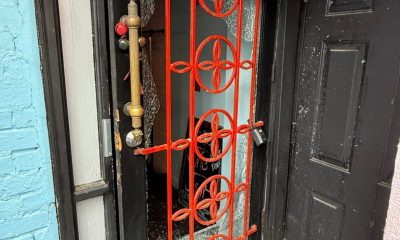a&e features
Webre’s farewell
Long-time Washington Ballet artistic director reflects
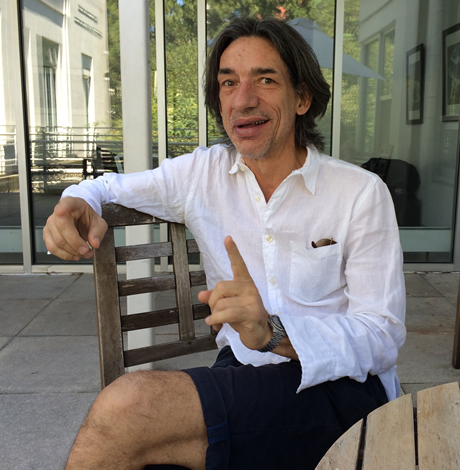
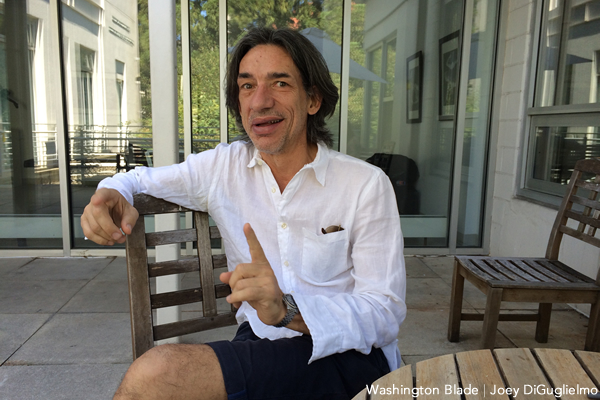
Septime Webre, artistic director of the Washington Ballet since 1999, says he worked to fuse classical ballet elements with contemporary and popular art during his tenure. (Washington Blade photo by Joey DiGuglielmo)
Imagination Stage Presents ‘The Little Mermaid’
In collaboration with the Washington Ballet
Continues through Aug. 14
Lerner Family Theatre
4908 Auburn Ave., Bethesda
Tickets start at $10
imaginationstage.org
Septime Webre didn’t plan on ‘The Little Mermaid,’ an Imagination Stage production produced in collaboration with the Washington Ballet, to be his swan song. It just kind of worked out that way.
But the 54-year-old co-choreographer says everything the Ballet has done this season — he mentions the April “Carmina Burana” performances and the “Bowie & Queen” rock show in May — as being fitting farewells. He wrapped his tenure at the Ballet this week and will join the S&R Foundation, a non-profit started in 2000 by Sachiko Kuno and Ryuji Ueno to support artists and scientists, as its artistic director.
During a Washington Blade interview, Webre — who lives in Adams Morgan with his partner of five years, Marc Cipullo — shared his philosophies, struggles and plans. His comments have been edited for length.
WASHINGTON BLADE: Why are you leaving?
SEPTIME WEBRE: I feel great about my accomplishments here. It’s grown amazingly. But particularly in the last few years, I’ve had a yearning to be in the studio a bit more. Being the director of a company, there are administration duties, PR duties, marketing duties, all that’s involved in overseeing an organization that has grown from a $2 million to a $12 million budget, so I had already been thinking that maybe another chapter would be interesting to really focus on creativity and less institution building for a while. That coincided with a blossoming of my work as a freelance artist in the last few years.
BLADE: Was the managerial aspect stultifying?
WEBRE: No. I’ve enjoyed all that institution building and felt like I wanted to do that while I was still somewhat young and energetic, or at least while my Grindr age was still young. I’m 54 but I skew young. I’m an energetic kind-of guy. So those duties weren’t stultifying, but they certainly got in the way of creating new work. In the last several years, I’ve done full-length ballets based on “The Great Gatsby,” on Hemingway’s “The Sun Also Rises,” last year I did a Washington Irving project and also “Alice in Wonderland.” These works have been much in demand over the last five or six years and I’ve also had some commissions by other companies.
BLADE: I assume the name recognition of these works helps?
WEBRE: That’s part of it but it’s also the return of narrative works in ballet after the era of modernism, which was my generation, and an aesthetic dominated by George Balanchine and Merce Cunningham. These were abstract artists and from the mid-century through the time I was dancing, serious choreographers really didn’t tackle narratives. It was not considered serious. But during my choreographic career, I began to tackle them because in many ways, it’s who I am. There’s something inside of me, this boisterous Cuban family and the brothers on the weekend, all we do is get together and drink cold Mexican beer and tell stories. So I was naturally drawn to these great books and they also happen to sell tickets.
BLADE: You were part of a larger trend with this?
WEBRE: I would say I was an early adopter of the return to narrative. … You could feel it in the air, particularly in the ‘90s. … It was a convergence of factors — the death of George Balanchine in the early ‘80s, we had been through modernism and that era and something new was needed. … Also just with the financial realities in the world, ballet companies were increasingly having to rely on box office in a financially challenging market and those story ballets sold better. … I was just on the front of a trend.
BLADE: How much of your work roughly has been choreographing vs. other duties at the Washington Ballet and did that change over time?
WEBRE: I’ve been creating a new work about every two years. That’s probably been the average. In the early years we did one a year, but they were smaller works. I would put my work into three different buckets. One is the creation of new ballet, the second is programmatic creativity, which I found really exciting. Curating repertoire, teaching, developing dancers, developing ancillary programs that are not creating ballets, but they’re really creative like the beerballet&bubbly series that brought thousands and thousands of Millennials in to watch rehearsals. … A third would be institution building.
BLADE: Did you ruffle many feathers along the way?
WEBRE: I never felt I ruffled feathers precisely, but I tried to push the envelope. I took over the Washington Ballet from Mary Day, who was 89 years old when I became the director. She was a fabulous visionary, but the company was a bit sleepy. She had a great aesthetic and she loved classical ballet and she loved new work, so there was a connection I had with her. But right away, the company began to grow. The audiences began to grow, we had standing ovations at every show the first run. In my first year, I took the Washington Ballet to Cuba, we produced a “Carmina Burana” that was, at that time, very unprecedented for us. Those first programs were so popular that a buzz developed very early on.
BLADE: You make it all sound so easy, though. What obstacles did you encounter?
WEBRE: Well, without a doubt our huge labor dispute in 2005. That was immense. We had grown so rapidly over the course of my first five years — the number of performances had probably doubled — we had grown, but the admin support hadn’t grown with it. …. We were working on a huge, new version of “The Nutcracker,” a huge project, and in the midst of that, the dancers very appropriately decided to join a union. That was the right time in our organization’s history to do that, but over the course of negotiating that first contract, which took a year, our “Nutcracker” was canceled and we lost a million dollars. The dancers were out of work for months and there was so much acrimony. We were in the Washington Post every day for 19 days, I think. …. But we were eventually able to settle it when we got the lawyers out of it. We settled in March 2006 and went back to work in April. That was a big one. …. Another challenge was in 2009 when the City Council eliminated earmarks. They rescinded that appropriation two months into our fiscal year and so suddenly we had a million dollar hole and we had to scramble. We had to cancel our “Nutcracker” orchestra to save $350,000 and we performed to taped music, just because otherwise we were not going to survive.
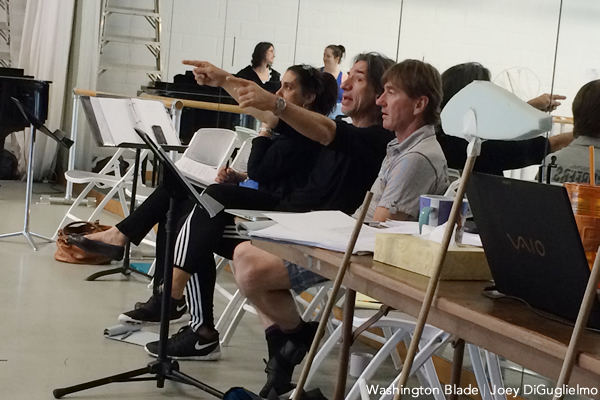
Septime Webre in rehearsal for ‘The Little Mermaid’ at the Washington Ballet studios on Wisconsin Avenue on June 10. (Washington Blade photo by Joey DiGuglielmo)
BLADE: What kind of learning curve did you have here?
WEBRE: I had some strong mentors and I was able to steal some of their ideas. But before this, although I had a little bit of training when I was a director for six years in Princeton, N.J., so my work there really impressed on me that you have to take your work with the audience a step further. You’re not in an ivory tower. You can’t just sort of hang the shingle and hope they’ll come and understand what you’re doing. You have to connect with them more deeply. I’d had some trial and error with that in New Jersey. So I came here with a conviction that the Washington Ballet had to connect with the social fabric of the city and we’ve done that in multiple ways with our outreach programs in Anacostia, Dance DC in public schools, beerballet&bubbly for young professionals, our Latino programs, etc.
BLADE: How have the dancers changed over the time you’ve been here?
WEBRE: About five years into my tenure here, just before the labor dispute actually, we’d never done any full-length classical ballets. No “Giselle,” “Coppelia” or “Don Quixote.” Mary Day never chose to do that because American Ballet was already doing that kind of repertoire at the Kennedy Center. I sensed a kind of unspoken inferiority complex around the organization. No one said it, but I could sense that the dancers thought we couldn’t handle it, our staff thought we couldn’t handle it, our audiences thought we couldn’t do it. A dancer’s career is so short, a dancer wants to dance the full repertory they were trained for, so I made a decision about four years in to slowly, methodically begin to introduce some full-length 19th Century classical works into the repertoire. … I think that helped us be seen as a grown-up company and that’s led to really, really high-powered dancers and a higher quality of dancer. Younger dancers today are coming in with a lot more technique and what a dancer can do now compared with 15 years ago or when I retired 20 years ago, oh my God — they’re doing all this crazy crap that hadn’t even been invented yet. Just like in athletics, the technique has risen, risen, risen.
BLADE: How has being gay affected your career or has it?
WEBRE: The dancers themselves are much less gay than the public imagines. … As I was getting into admin work and started working with board members … I actually found it to be an asset. This is going to sound very retro, but it gave me a kind of exoticism. … They were a lot of businessmen who didn’t necessarily have gay friends, so now they did and it made them feel good about themselves.
BLADE: Are classical works and pop/contemporary works strange bedfellows in the ballet world?
WEBRE: Well, “Giselle” sold significantly less well than “The Great Gatsby” or than “Bowie & Queen.” “Don Quixote” sold less than “The Sun Also Rises” or “The British Invasion.” What I found was that when classical, lofty art remained itself and didn’t get a bit dirty, it was less popular from a ticket sale standpoint. So we remained ballet, but we got down and dirty with Freddie Mercury wailing sometimes. That collision creates a buzz and a connection. … But things are always colliding and mixing in a postmodern world. I mean, I wish everyone loved “Giselle” as much as I do, but it’s also exciting because ballet is a language just like you use the same English language for Shakespeare, Emily Dickinson or Mad Magazine.
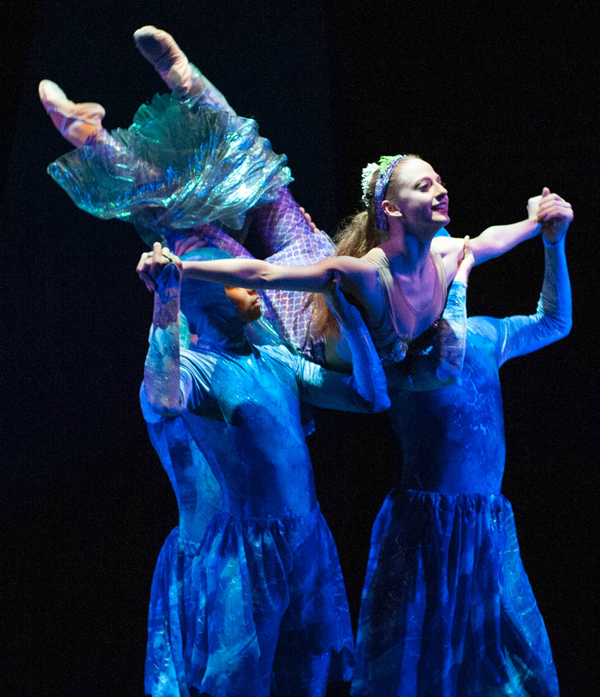
The cast of ‘The Little Mermaid.’ (Photo courtesy Imagination Stage)
Jesse Arnholz contributed to this interview.
a&e features
Doug Spearman takes his chance
‘Noah’s Arc: The Movie’ debuted on Paramount+ last month
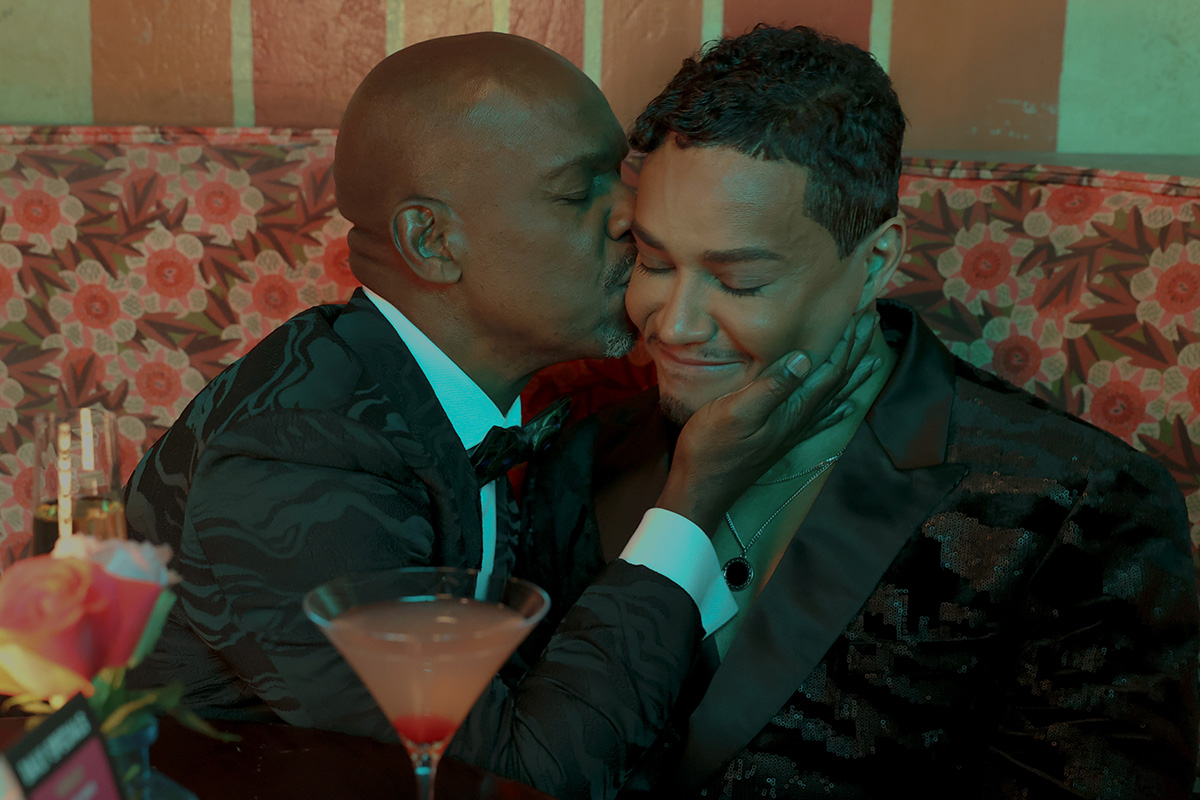
There’s no question that when Patrik-Ian Polk’s series “Noah’s Arc” premiered on Logo 20 years ago, it was a groundbreaking creation. The story of a group of Black gay men and their wonderful friendship. The titular arc was that of the cute main character, Noah (Darryl Stephens), and his close-knit circle of friends, including Chance played by gay actor Doug Spearman. This compelling and loving fraternity may, in fact, be what brought viewers back repeatedly, including a 2008 movie, “Noah’s Arc: Jumping the Broom,” as well as the 2020 “Noah’s Arc” short, and now, a new full-length feature “Noah’s Arc: The Movie,” debuting on Paramount+ on June 20. In the movie, filled with equal measures of laughs and tears, Chance, who has faced a devastating loss, finds his dependable friends there, ready to support and comfort him at a moment’s notice. I had the pleasure of speaking with Spearman the morning of the streaming premiere of “Noah’s Arc: The Movie.”
WASHINGTON BLADE: Doug, since the early 2000s, when the “Noah’s Arc” series premiered on Logo, you have been playing the character of Chance, including in the latest installment, “Noah’s Arc: The Movie.” What was it about Chance that appealed to you as an actor?
SPEARMAN: When Patrik (-Ian Polk) called me to ask me to play him (Chance), I was at JFK airport in the baggage claim, waiting for a suitcase. He explained what the part was. The thing that stuck out to me was the fact that Chance was in a long-term relationship with another Black man. And, they had a child; they had a 4-year-old daughter named Kenya. I had never seen two Black gay men raise a child on TV before. I thought it was the most revolutionary thing I’d ever seen. I immediately thought I’ve got to do this because that was something nobody had seen. I thought it was incredibly important to take the part.
BLADE: “Noah’s Arc: The Movie” was, once again, written and directed by Patrik-Ian Polk, who you just mentioned, is the creator of the entire franchise. What’s the secret to your long-standing working relationship?
SPEARMAN: [Laughs] the whole team, all of us, are like a band of brothers. We fight like brothers, we come together like brothers, we hash things out, we talk, because we’re all very different from our characters. I think the challenge of playing these guys and then uplifting these men, playing a part, especially something written by Patrik, is like solving a math equation. There’s always a challenge that’s enjoyable for me as an actor: to try to find out what it is that Patrik wants, and then how do I do it.
BLADE: I think you do a very good job of it.
SPEARMAN: Thank you very much
BLADE: In the years between “Jumping the Broom” and the new full-length movie, many changes have occurred, and the story addresses some of them, including gay widowhood, which is something that the aging community is now confronting, as well as mental health issues. Please say a few words about how you approached those subjects in the new movie.
SPEARMAN: I had a lot of loss in my life, right before we started shooting. Two months before we started shooting the first series, my mother died. I was going through the grief process through that whole first season. Since then, I’ve lost a lot of people in my life. In fact, when we started shooting the second season, the second week we were shooting, my ex died of a heart attack. I was having to fold that into what I was doing with my life on the set and off the set. You’ve got to show up and you’ve got to do your work. The first two seasons of “Noah’s Arc” are always tinged with the memory of grief. So, when I had to deal with the death that Chance faces (in the new movie), which is a significant death in his life, it wasn’t that hard to reach back, especially the scene in the graveyard. It was something that I unfortunately could pull from personal experience.
BLADE: Shifting gears, the movie features delightful cast surprises, including Jasmine Guy and TS Madison. Did you have a chance to interact with either or both when they were on set?
SPEARMAN: No, I didn’t have any scenes with Jasmine, and I missed her. I wish I had gotten to see her because I actually got to direct Jasmine for a CBS promo shoot for “Queen,” back in the early ‘90s. I had a huge crush on her when she was on “A Different World.” So, I really would have liked to reconnect. But TS and I got to see each other every day because I was in all her scenes. It was extraordinary being around somebody like that. That is one outspoken woman!
BLADE: Even though Beyoncé never makes an appearance in the movie, there’s a lot of talk about her. Would you say you are a Beyoncé fan?
SPEARMAN: Yes! I’m breathing! Yes, I’m a Beyoncé fan. I actually got the chance to meet her. I knew her mom. Her mom was extraordinary to me. She is in the second movie I directed. She also gave us a wedding gown to use in the very first scene of the movie. That family is extraordinarily important to me. Not only just to be a fan, but to be somebody who’s gotten to know them and work with them and see how hard they work. I don’t think anybody works as hard as Tina or Beyoncé.
BLADE: There was a recent news item about gay actor Benito Skinner of the Amazon Prime series “Overcompensating” being told not to bother auditioning for straight roles. As an out actor yourself, how important do you think it is for queer characters to be portrayed by queer actors, and vice versa?
SPEARMAN: Being queer is a multifaceted identity. There’s no one kind of queer person. I think finding the best actor that’s your first circle of casting. I think one of the joys about being an actor is that you get to play different parts. I play straight guys all the time. Dads and husbands and things like that. I think a lot of people are told not to do it. In fact, I wouldn’t be Chance if the actor who was originally cast as Chance hadn’t been pulled out of the series by his agents because they didn’t want him to play a gay character.
BLADE: That’s amazing! Thank you for sharing that. Without giving away too much, the ending of the movie is a little ambiguous, even ending with a question mark. If there was a “Noah’s Arc: The Movie” sequel, would you come back for that?
SPEARMAN: Yeah! A lot of it would depend on what Chance’s journey is going to be like. Patrik and I have conversations like that all the time. He’s very interested and supportive of input. I hope I would be, as we all would be, part of the creative growth with these characters. They live in Patrik’s head, and he writes them, but we’re the ones who have to flesh them out. It’s a conversation, it’s always a conversation.
BLADE: You are currently performing in Molière’s “The Imaginary Invalid” as part of the New Orleans Shakespeare Festival at Tulane. What has this experience been like for you?
SPEARMAN: It’s extraordinary! I started on stage when I was seven. There’s nothing like working with a live audience and having that immediacy. I’m working with an extraordinarily talented cast in a really great play, and I have some of the best scene partners I could ever want.
BLADE: Are there any upcoming film or TV projects you’d like to mention?
SPEARMAN: I’m still a writer, and I’m still a director, and I’ve still got scripts that I would like to make. I have a little something that’s a cross between “Treme” and “Bridgerton” that I want to do. I’m always trying to figure out what the next thing is.
a&e features
Visit Cambridge, a ‘beautiful secret’ on Maryland’s Eastern Shore
New organization promotes town’s welcoming vibe, LGBTQ inclusion
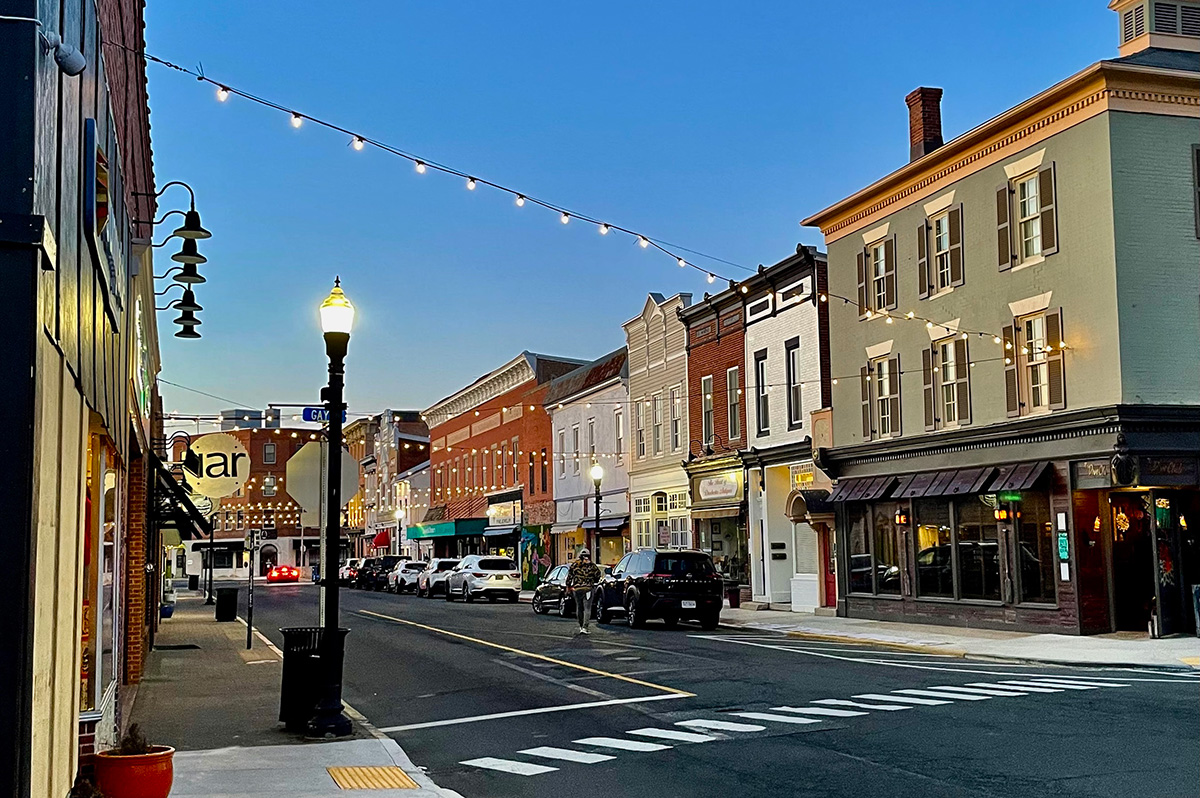
CAMBRIDGE, Md. — Driving through this scenic, historic town on Maryland’s Eastern Shore, you’ll be charmed by streets lined with unique shops, restaurants, and beautifully restored Victorian homes. You’ll also be struck by the number of LGBTQ Pride flags flying throughout the town.
The flags are a reassuring signal that everyone is welcome here, despite the town’s location in ruby red Dorchester County, which voted for Donald Trump over Kamala Harris by a lopsided margin. But don’t let that deter you from visiting. A new organization, Proudly Cambridge, is holding its debut Pride event this weekend, touting the town’s welcoming, inclusive culture.
“We stumbled on a beautiful secret and we wanted to help get the word out,” said James Lumalcuri of the effort to create Proudly Cambridge.
The organization celebrates diversity, enhances public spaces, and seeks to uplift all that Cambridge has to share, according to its mission statement, under the tagline “You Belong Here.”
The group has so far held informal movie nights and a picnic and garden party; the launch party is June 28 at the Cambridge Yacht Club, which will feature a Pride celebration and tea dance. The event’s 75 tickets sold out quickly and proceeds benefit DoCo Pride.
“Tickets went faster than we imagined and we’re bummed we can’t welcome everyone who wanted to come,” Lumalcuri said, adding that organizers plan to make “Cheers on the Choptank” an annual event with added capacity next year.
One of the group’s first projects was to distribute free Pride flags to anyone who requested one and the result is a visually striking display of a large number of flags flying all over town. Up next: Proudly Cambridge plans to roll out a program offering affirming businesses rainbow crab stickers to show their inclusiveness and LGBTQ support. The group also wants to engage with potential visitors and homebuyers.
“We want to spread the word outside of Cambridge — in D.C. and Baltimore — who don’t know about Cambridge,” Lumalcuri said. “We want them to come and know we are a safe haven. You can exist here and feel comfortable and supported by neighbors in a way that we didn’t anticipate when we moved here.”
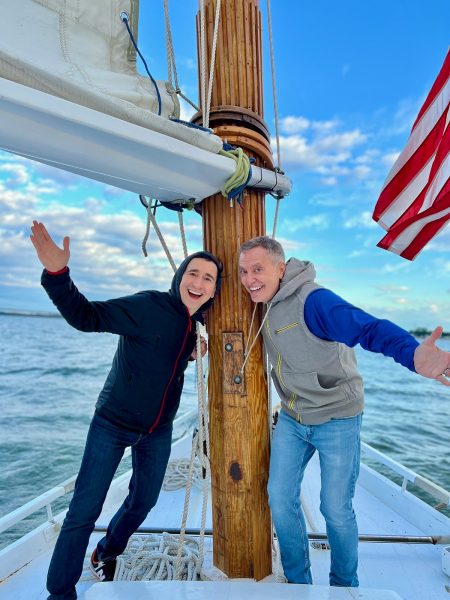
Lumalcuri, 53, a federal government employee, and his husband, Lou Cardenas, 62, a Realtor, purchased a Victorian house in Cambridge in 2021 and embarked on an extensive renovation. The couple also owns a home in Adams Morgan in D.C.
“We saw the opportunity here and wanted to share it with others,” Cardenas said. “There’s lots of housing inventory in the $300-400,000 range … we’re not here to gentrify people out of town because a lot of these homes are just empty and need to be fixed up and we’re happy to be a part of that.”
Lumalcuri was talking with friends one Sunday last year at the gazebo (affectionately known as the “gayzebo” by locals) at the Yacht Club and the idea for Proudly Cambridge was born. The founding board members are Lumalcuri, Corey van Vlymen, Brian Orjuela, Lauren Mross, and Caleb Holland. The group is currently working toward forming a 501(c)3.
“We need visibility and support for those who need it,” Mross said. “We started making lists of what we wanted to do and the five of us ran with it. We started meeting weekly and solidified what we wanted to do.”
Mross, 50, a brand strategist and web designer, moved to Cambridge from Atlanta with her wife three years ago. They knew they wanted to be near the water and farther north and began researching their options when they discovered Cambridge.
“I had not heard of Cambridge but the location seemed perfect,” she said. “I pointed on a map and said this is where we’re going to move.”
The couple packed up, bought a camper trailer and parked it in different campsites but kept coming back to Cambridge.
“I didn’t know how right it was until we moved here,” she said. “It’s the most welcoming place … there’s an energy vortex here – how did so many cool, progressive people end up in one place?”
Corey van Vlymen and his husband live in D.C. and were looking for a second home. They considered Lost River, W.Va., but decided they preferred to be on the water.
“We looked at a map on both sides of the bay and came to Cambridge on a Saturday and bought a house that day,” said van Vlymen, 39, a senior scientist at Booz Allen Hamilton. They’ve owned in Cambridge for two years.
They were drawn to Cambridge due to its location on the water, the affordable housing inventory, and its proximity to D.C.; it’s about an hour and 20 minutes away.
Now, through the work of Proudly Cambridge, they hope to highlight the town’s many attributes to residents and visitors alike.
“Something we all agree on is there’s a perception problem for Cambridge and a lack of awareness,” van Vlymen said. “If you tell someone you’re going to Cambridge, chances are they think, ‘England or Massachusetts?’”
He cited the affordability and the opportunity to save older, historic homes as a big draw for buyers.
“It’s all about celebrating all the things that make Cambridge great,” Mross added. “Our monthly social events are joyful and celebratory.” A recent game night drew about 70 people.
She noted that the goal is not to gentrify the town and push longtime residents out, but to uplift all the people who are already there while welcoming new visitors and future residents.
They also noted that Proudly Cambridge does not seek to supplant existing Pride-focused organizations. Dorchester County Pride organizes countywide Pride events and Delmarva Pride was held in nearby Easton two weeks ago.
“We celebrate all diversity but are gay powered and gay led,” Mross noted.
To learn more about Proudly Cambridge, visit the group on Facebook and Instagram.
What to see and do
Cambridge, located 13 miles up the Choptank River from the Chesapeake Bay, has a population of roughly 15,000. It was settled in 1684 and named for the English university town in 1686. It is home to the Harriet Tubman Museum, mural, and monument. Its proximity to the Blackwater National Wildlife Refuge makes it a popular stop for birders, drawn to more than 27,000 acres of marshland dubbed “the Everglades of the north.”
The refuge is walkable, bikeable, and driveable, making it an accessible attraction for all. There are kayaking and biking tours through Blackwater Adventures (blackwateradventuresmd.com).
Back in town, take a stroll along the water and through historic downtown and admire the architecture. Take in the striking Harriet Tubman mural (424 Race St.). Shop in the many local boutiques, and don’t miss the gay-owned Shorelife Home and Gifts (421 Race St.), filled with stylish coastal décor items.
Stop for breakfast or lunch at Black Water Bakery (429 Race St.), which offers a full compliment of coffee drinks along with a build-your-own mimosa bar and a full menu of creative cocktails.
The Cambridge Yacht Club (1 Mill St.) is always bustling but you need to be a member to get in. Snapper’s on the water is temporarily closed for renovations. RaR Brewing (rarbrewing.com) is popular for craft beers served in an 80-year-old former pool hall and bowling alley. The menu offers burgers, wings, and other bar fare.
For dinner or wine, don’t miss the fantastic Vintage 414 (414 Race St.), which offers lunch, dinner, wine tasting events, specialty foods, and a large selection of wines. The homemade cheddar crackers, inventive flatbreads, and creative desserts (citrus olive oil cake, carrot cake trifle) were a hit on a recent visit.
Also nearby is Ava’s (305 High St.), a regional chain offering outstanding Italian dishes, pizzas, and more.
For something off the beaten path, visit Emily’s Produce (22143 Church Creek Rd.) for its nursery, produce, and prepared meals.
“Ten minutes into the sticks there’s a place called Emily’s Produce, where you can pay $5 and walk through a field and pick sunflowers, blueberries, you can feed the goats … and they have great food,” van Vlymen said.
As for accommodations, there’s the Hyatt Regency Chesapeake Bay (100 Heron Blvd. at Route 50), a resort complex with golf course, spa, and marina. Otherwise, check out Airbnb and VRBO for short-term rentals closer to downtown.
Its proximity to D.C. and Baltimore makes Cambridge an ideal weekend getaway. The large LGBTQ population is welcoming and they are happy to talk up their town and show you around.
“There’s a closeness among the neighbors that I wasn’t feeling in D.C.,” Lumalcuri said. “We look after each other.”
a&e features
James Baldwin bio shows how much of his life is revealed in his work
‘A Love Story’ is first major book on acclaimed author’s life in 30 years
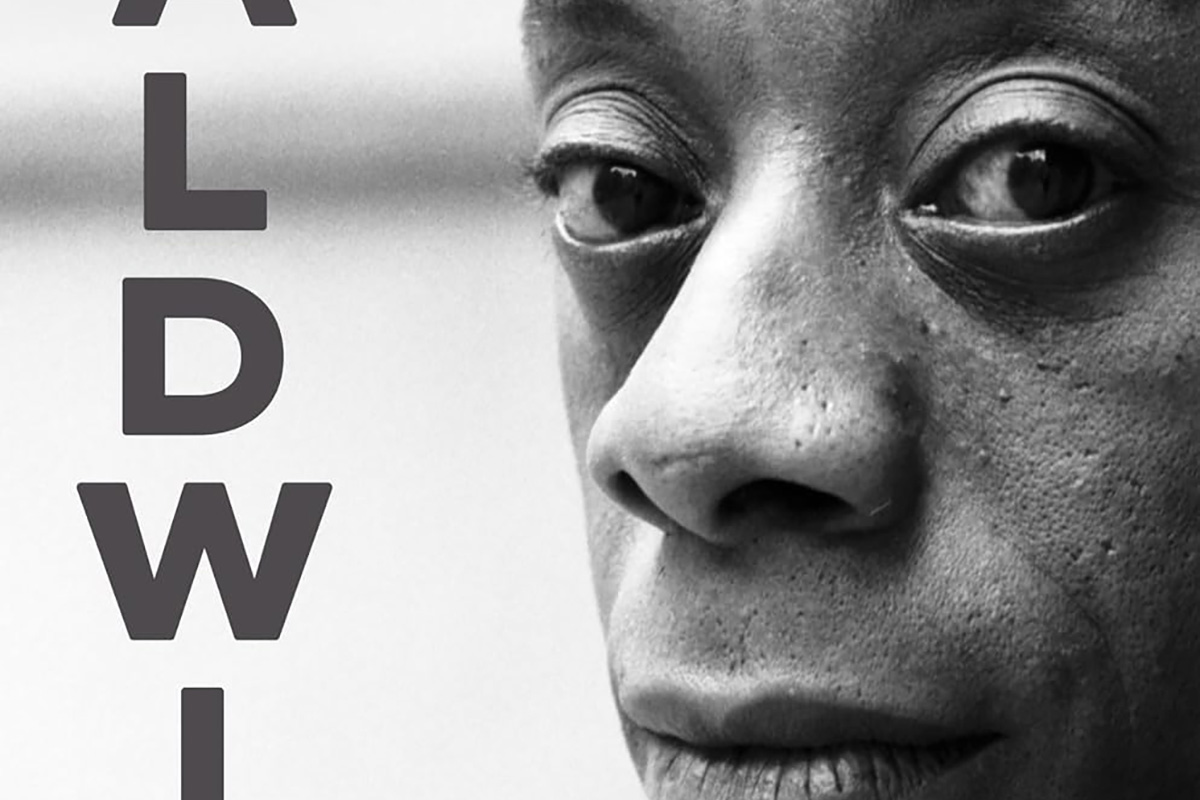
‘Baldwin: A Love Story’
By Nicholas Boggs
c.2025, FSG
$35/704 pages
“Baldwin: A Love Story” is a sympathetic biography, the first major one in 30 years, of acclaimed Black gay writer James Baldwin. Drawing on Baldwin’s fiction, essays, and letters, Nicolas Boggs, a white writer who rediscovered and co-edited a new edition of a long-lost Baldwin book, explores Baldwin’s life and work through focusing on his lovers, mentors, and inspirations.
The book begins with a quick look at Baldwin’s childhood in Harlem, and his difficult relationship with his religious, angry stepfather. Baldwin’s experience with Orilla Miller, a white teacher who encouraged the boy’s writing and took him to plays and movies, even against his father’s wishes, helped shape his life and tempered his feelings toward white people. When Baldwin later joined a church and became a child preacher, though, he felt conflicted between academic success and religious demands, even denouncing Miller at one point. In a fascinating late essay, Baldwin also described his teenage sexual relationship with a mobster, who showed him off in public.
Baldwin’s romantic life was complicated, as he preferred men who were not outwardly gay. Indeed, many would marry women and have children while also involved with Baldwin. Still, they would often remain friends and enabled Baldwin’s work. Lucien Happersberger, who met Baldwin while both were living in Paris, sent him to a Swiss village, where he wrote his first novel, “Go Tell It on the Mountain,” as well as an essay, “Stranger in the Village,” about the oddness of being the first Black person many villagers had ever seen. Baldwin met Turkish actor Engin Cezzar in New York at the Actors’ Studio; Baldwin later spent time in Istanbul with Cezzar and his wife, finishing “Another Country” and directing a controversial play about Turkish prisoners that depicted sexuality and gender.
Baldwin collaborated with French artist Yoran Cazac on a children’s book, which later vanished. Boggs writes of his excitement about coming across this book while a student at Yale and how he later interviewed Cazac and his wife while also republishing the book. Baldwin also had many tumultuous sexual relationships with young men whom he tried to mentor and shape, most of which led to drama and despair.
The book carefully examines Baldwin’s development as a writer. “Go Tell It on the Mountain” draws heavily on his early life, giving subtle signs of the main character John’s sexuality, while “Giovanni’s Room” bravely and openly shows a homosexual relationship, highly controversial at the time. “If Beale Street Could Talk” features a woman as its main character and narrator, the first time Baldwin wrote fully through a woman’s perspective. His essays feel deeply personal, even if they do not reveal everything; Lucian is the unnamed visiting friend in one who the police briefly detained along with Baldwin. He found New York too distracting to write, spending his time there with friends and family or on business. He was close friends with modernist painter Beauford Delaney, also gay, who helped Baldwin see that a Black man could thrive as an artist. Delaney would later move to France, staying near Baldwin’s home.
An epilogue has Boggs writing about encountering Baldwin’s work as one of the few white students in a majority-Black school. It helpfully reminds us that Baldwin connects to all who feel different, no matter their race, sexuality, gender, or class. A well-written, easy-flowing biography, with many excerpts from Baldwin’s writing, it shows how much of his life is revealed in his work. Let’s hope it encourages reading the work, either again or for the first time.
-

 U.S. Supreme Court2 days ago
U.S. Supreme Court2 days agoSupreme Court to consider bans on trans athletes in school sports
-

 Out & About2 days ago
Out & About2 days agoCelebrate the Fourth of July the gay way!
-
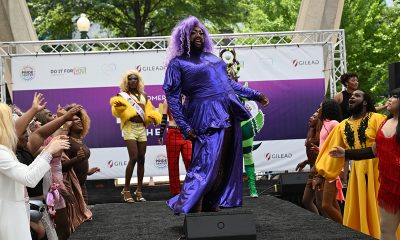
 Maryland5 days ago
Maryland5 days agoSilver Spring holds annual Pride In The Plaza
-

 Opinions5 days ago
Opinions5 days agoSupreme Court decision on opt outs for LGBTQ books in classrooms will likely accelerate censorship

